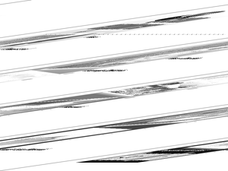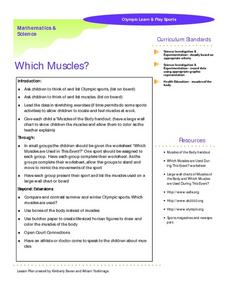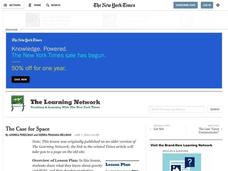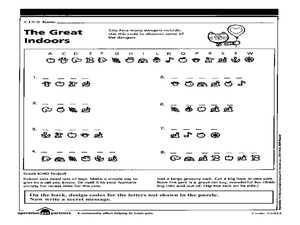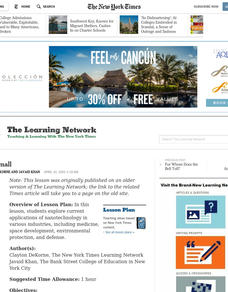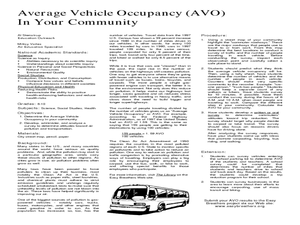Curated OER
What's the Connection?
Students explain hardground communities in the Gulf of Mexico. In this deep-sea ecosystem lesson, students investigate the connection between deep-sea ecosystems and petroleum deposits. They discuss the relationship between hydrocarbon...
Curated OER
When Plates Collide
Students investigate tectonic plates. In this geology and geography lesson, students construct convergent, divergent, and transform boundaries using oobleck, foam, and tile. A large amount of background information and relevant website...
Curated OER
Which Muscles?- Olympic Learn and Play Sports
In this math, science, and physical education worksheet, students brainstorm and study about the muscles that are used while participating in different Olympic sports. They color the muscle groups of the body by follow the directions...
Curated OER
What's Eating Titanic?
Students, in groups, research the bio deterioration of the Titanic. They write a report focusing on the rusting of the Titanic and estimate the amount of time it will take for the Titanic's bow section to completely dissolve.
Curated OER
Exercise Stations
Students participate in station activities in P.E. In this physical education instructional activity, students do station activities. Students start out with a warm up exercise then make their way to dance, bowling, scooters, jump rope,...
Curated OER
No Place Like Home?
Students investigate the impact of the physical environment on an endangered species. They create a plan for the ideal care of the species and develop an advertisement to promote awareness about the need for its protection.
Curated OER
Slush Rush
Young scholars navigate software to help students understand the benefits of computer models. In this computer models lesson, young scholars use computer inquiry tools to record simulated events and how they affect objects such as...
Curated OER
Layers of the Earth: Plate Tectonics
Sixth graders participate in a lesson that is about investigating the different layers of the earth and defining how the plates move over the mantle. They engage in a variety of activities and use mathematics to create projects to...
Curated OER
PV=nRT=Bang!
In this ideal gas law worksheet, students watch a demonstration using liquid nitrogen, a plastic 2 liter bottle and a garbage can of water that excites kids to use the ideal gas law to solve problems. Students analyze the results of the...
Curated OER
3-D Magnetic Field
In this magnetism learning exercise, students build a 3 dimensional magnetic field by using a juice bottle, a test tube, iron fillings and a magnet. Students write a descriptive story about what they observe once their bottle is complete...
Curated OER
The Case for Space
In this instructional activity, learners share what they know about gravity and flight, and then develop marketing strategies promoting careers in aerospace to young people. Using what they have learned, they then write recommendation...
Curated OER
Fabulous Felines: Keeping Cats Safe
Students discover ways to protect their pets. For this animal safety lesson, students role-play as pet "safety officers" and discuss how to make sure cats avoid dangers in the home. Students complete many pet safety worksheets and...
Curated OER
Constructing a Periodic Table of Elements
Students create a periodic table of elements. In this chemistry lesson, students work together to build all of the different elements into a complete mini periodic table. They identify similarity and difference of the elements.
Curated OER
Hot Air Ballooning: Exploring Charles' Law
Students solve word problems dealing with Charles' Law. In this Charles' Law instructional activity, students observe PowerPoint presentations concerning Charles' Law. They complete a WebQuest and describe the relationship between hot...
Curated OER
Think Small
Students explore current applications of nanotechnology in various industries, including medicine, space development, environmental protection, and defense.
Curated OER
Pop Rocket - Trash to Treasure
First off, Newton's laws of motion aren't often taught at 2nd grade, so this lesson may be more appropriate for upper elementary learners. It begins with a discussion and demonstration of the laws of motion, and then has individuals...
Curated OER
Football Physics "Having A Ball With Projectile Motion"
Students examine the concept of projectile motion and identify the 3 components of projectile motion. They explore how physics applies to punting a football through punting activities and internet research.
Curated OER
The Letter Qq
Students complete a variety of activities to examine the uses for the letter Q. In this letter theme lesson, students complete arts and crafts, language arts, math, physical education, music, science, home economics, social studies, and...
Curated OER
How to Grow a Cactus Indoors
Students plant a cacti. In this desert plants lesson, students identify the needs of a plant and meet those needs by planting and caring for cactus.
Curated OER
Average Vehicle Occupancy In Your Community
Students determine the average vehicle occupancy in their community. In this transportation lesson students develop and analyze a survey to determine attitudes towards air pollution and transportation.
Curated OER
What are Alternative Fuels? -- Gas Laws in Action/Propane Investigation
Pupils identify the physical properties of propane by applying the gas laws to them. They compare and contrast Charles's and Boyle's gas laws and complete problems using them. They discuss their answers to end the lesson.
Curated OER
Roller Coasters in the Classroom
Students define kinetic energy and know the effects of weight and speed on momentum. In this investigative lesson students get into groups and design a roller coaster.
Curated OER
Consuming Healthy Snacks
Get your class into great shape by introducing them to the benefits of eating healthy snacks and engaing in regular exercise. This set of activities comes with all the worksheets and handouts needed to complete several weeks of nutrition...
Curated OER
The Circulatory System--Part VI
Students outline a body on butcher paper. Students fill in the circulatory system using materials of various textures. Students decorate all the parts of the circulatory system with art articles, like buttons, yarn, etc.



